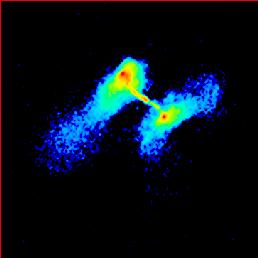 Image:
Image:3C 305 | B1448+634 |
| S178 | Alpha | FR | Class | ID | Spectrum | Best z | mag. | LAS | lg P178 | D |
|---|---|---|---|---|---|---|---|---|---|---|
| 17.1 | 0.85 | I | PD | Gal | 0.0410 | V = 13.75 | 13.60 | 24.65 | 10.1 |
| Size: | 16.2 × 16.2 arcsec² |
|---|---|
| LUT: | Logarithmic |
| Beam: | 0.15 arcsec |
| Frequency: | 1534 MHz |
| Method: | CLEAN/VTESS’ėˇ>0.15
|
| Telescope: | MERLIN/VLA |
| Credits: | Leahy (1997), Condon, Machalski & Wrobel (1997) |
3C 305 is very small for an intermediate-luminosity DRAGN, being entirely confined within its host galaxy. It has a "plumed double" structure, i.e. it is dominated by compact hotspots, with the lobes forming plumes extending outwards, instead of the usual bridge stretching back towards the centre. The hotspots are sited at the ends of a pair of narrow jets, moderately asymmetric in brightness. The jets are slightly curved in an S-shape, suggesting that the ejection axis is slowly precessing anticlockwise.
IC 1065 has been called both a spiral and an elliptical galaxy, but neither description is accurate. The definitive study is by Heckman et al. (1985a). Although the central regions look like a normal elliptical, apart from extensive patches of dust and line-emitting gas, there are clear spiral features in the outer parts. However long-slit spectra of the stellar absorption lines show that the stars lack the coherent motions of a true spiral disk, yet have a much larger systematic rotation than in a normal large elliptical. The galaxy appears to be an oblate spheroid, rotating around a roughly north-south axis in the sense that the eastern side is approaching, and tilted so that the northern side is furthest away. Heckman et al. argue strongly that IC 1065 is the result of a recent merger between two galaxies, at least one of which was a gas-rich spiral.
Heckman et al. (1982) showed that the DRAGN is intimately connected with the emission-line nebula at the centre of IC 1065. The nebula forms a Z-shaped structure centred on the nucleus, with the bar of the Z nearly parallel to the radio jets, and the corners of the Z at about the position of the hotspots; these are also the sites of the strongest line emission. The outer arms of the Z lie just beyound the radio lobes. Spectroscopy shows that the gas is moving much faster than the stars in the galaxy, with the North-Eastern gas approaching and the South-Western gas receding from us. Almost certainly the gas motion has been disturbed by the impact of the radio jets. In fact, the actual line emission is thought to come from tiny condensations inside dense gas clouds which are otherwise invisible. These clouds take the impact of the jets, and are therefore responsible for confining the DRAGN to such a small size. From the gas velocities, we can tell that the NE jet is approaching and the SW jet is receding. The difference in brightness between the two jets might therefore be due to relativistic beaming.
The unusual structure of 3C 305 may be related to the clumpyness
of the gas in IC 1065. Although the gas clouds prevent expansion
along the jet axis, the jet material can escape around the sides of
the clouds to form the plumes. The anticlockwise rotation of the galaxy
may stretch out the plumes to contribute to the rough rotational
symmetry of the DRAGN.
| Prev. | Data Page | Other images | Next | Search | Alphanumeric List | Icon List | Atlas Index |
|---|